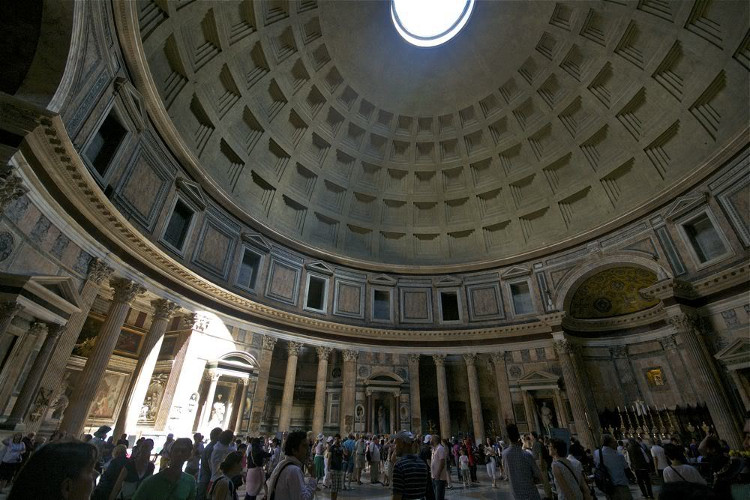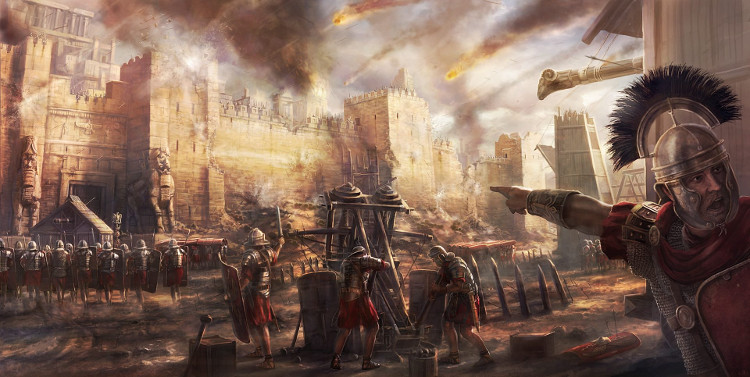Great architectural inventions of the Romans
Although not good at calculating, the Romans were geniuses in shaping, experimenting, designing and building works for life.
Although not good at calculating, the Romans were geniuses in shaping, experimenting, designing and building works for life. Join us in exploring the 10 greatest inventions in the architectural history of the Roman Empire.
Arch architecture

From time immemorial, if you look at the pyramid or Parthenon temple, you can see to build such a massive structure that needs a series of big stone pillars or structures to withstand. This makes the interior of the Parthenon temple very tight and narrow.
On the outside, the arch architecture is as massive as the pyramid, or the Parthenon temple. But the inner space has shown the pinnacle of brick-built architecture. Starting from a central point on the ceiling, the arches spread out along the arch space, creating a sense of 3-dimensional space when viewed on the ceiling. The center of the dome can be closed or open, thus making the interior space of the dome more spacious and bright than massive structures like pyramids or Parthenon temples. In order to obtain such solid shells, the Romans used a lot of concrete while designing the building.
City weapons

If you're a fan of empire or medieval war games, the player will be no stranger to a ballistae or a catapults . These are the two types of famous Roman weapons of the Romans. By stretching a bow string on a rack, when the arched wire can shoot an arrow, or kick the target at a distance of 457 meters with great damage power. The name shooter can fire large or large arrows to shoot down enemy troops or small buildings when the army is successful. The catapult also relies on the tension of the tie to throw away round or flint stones. This type of weapon is less accurate than an arrow but gives a higher chance of destruction when it comes to the city.
Concrete

Concrete is the foundation to build fancy arch architectures. And of course, concrete is also a masterpiece of the Romans. The main components of Roman concrete include: rubber, lime, sand and volcanic ash. When pouring into wooden molds, concrete will form a stronger and stronger material than all of their original components. Not only that, concrete is constantly being improved throughout the construction process. The most obvious proof of this is the Pantheon temple, which still stands after more than 2,000 years.
Concrete is a breakthrough material from ancient Greek architecture - supporting buildings with walls and pillars. Concrete is both more resistant, cheaper, fire resistant, can be submerged under water and more flexible in fighting earthquakes.
Road

If you compare current daily plastic roads with the ancient Roman roads, then how does one compare a cheap watch with a genuine Rolex. The ancient roads of the Romans were strong, stable and even used until now.
The process of building roads of the Romans is very sophisticated. First they dig 3 meters deep in the terrain they plan to make. After that, these deep grooves will be filled with heavy stones. Sand or gravel will be covered with this stone. Finally, the top part of the road will be covered with flat pieces of stone, alternating grooves for water to flow through. In short, with such architecture, the Roman road will be about 3 meters thick and nearly impossible to wear.
Considering the aesthetic appeal of the Romans when building roads, houses were never placed next to the road and the roadsides were always airy. Once the road was built, the Romans would definitely "level" the entire terrain on the roadside to create an airy space for the road. With such unique characteristics, even now, Roman roads are still being used.
Sewer system

Cloaca Maxima is a channel to discharge the original swamp. After about 700 years, due to increased demand for drainage routes, the Romans decided to expand this sewer system as much as possible to anticipate future needs. The sewer system is increasingly expanded and deepened into the city center. According to archaeologists, this 2000-year-old tunnel system is not simply for drainage. It can be used for many purposes, such as escape.
Floor keep heat

When it comes to heating, people think of heating or air conditioning. But thousands of years ago, fire was the only means to help people warm. This did not affect the creativity of the ancient Romans because they also had "air conditioning" in the form of fireplaces placed on the floor, or hidden in clay pillars in the house. This heater is usually a hot water tank. When boiling water, hot air and steam will spread from the floor to the entire house.
Water pipe

Plumbing is also a work that made the name of the ancient Romans into history. In Roman cities, very long water pipes existed to overcome the shortage of water. For convenience, the ancient Roman engineers built a system of water pipes buried right under the bridge, under normal water sources. The pipes will carry water from Rome to the surrounding suburbs. The total length of the Roman plumbing system is up to 402km.
Water wheel

Since ancient times, ancient Romans were very famous for devices that used water power to operate such as saws, flour mills, turbines. However, the famous classical device of the Romans was a floating mill. The floats with water wheels are built right in the middle of the river, whereby the flow of water will turn the wheel. These floating wheel houses are used to grind cereals. In fact, floating houses with water wheels were once the savior of Gothic when in 537 AD, the city was surrounded and received no food supplies. At that time, General Belisarius decided to build floating water wheel houses to produce food for the goalkeeper.
Arch architecture

Arch architecture is not a Roman invention. However, the Romans were excellent in improving the "dome architecture". "The arch architecture does not necessarily have to be seamless" is the conclusion of Roman design engineers. Just using a part of the arch architecture, many buildings with "eye-catching" arc architectures emerged from Roman times.
Pontoon bridge

Marching speed is one of the unexpected factors that can change in Roman battles. The pontoon bridge is also aimed at this purpose."Simple and effortless, almost no intervention on topography" are the reasons for the floating pontoon bridge. A typical example in history is the pontoon bridge built by Julius Caesar in 55 BC, with a length of 400 m across the Rhine River.
- Great inventions did not win the Nobel Prize
- Incredible but great inventions
- 10 interesting inventions of ancient Egyptians (II)
- Great but great inventions
- Funny death of ancient Romans
- 10 famous architectural masterpieces through the era
- How did the ancient Romans create heating systems?
- Seeing the Great Wall from the universe: Fiction?
- How to help Romans have beautiful white teeth without toothpaste
- The elevator goes up and down is the old technology, this is the elevator of the future
- 11 incredible 'inventions' come from the past
- 15 quirky inventions but the idea is quite interesting
 Daily use inventions come from universities
Daily use inventions come from universities Special weight loss device helps prevent appetite
Special weight loss device helps prevent appetite 8 inventors were killed by their own inventions
8 inventors were killed by their own inventions Iran invented a motor car powered by water
Iran invented a motor car powered by water